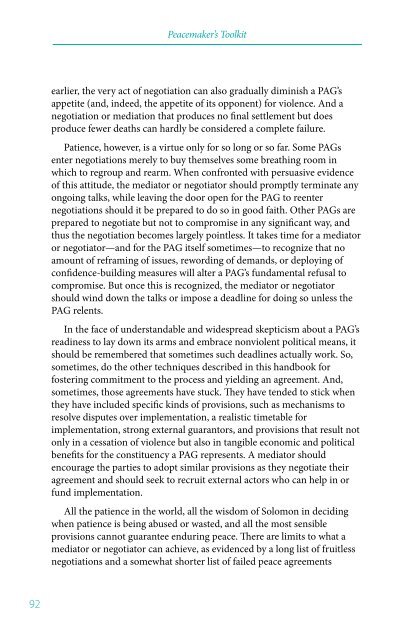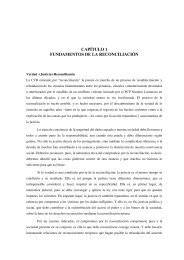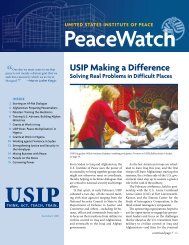Talking to Groups that Use Terror.pdf - United States Institute of Peace
Talking to Groups that Use Terror.pdf - United States Institute of Peace
Talking to Groups that Use Terror.pdf - United States Institute of Peace
Create successful ePaper yourself
Turn your PDF publications into a flip-book with our unique Google optimized e-Paper software.
<strong>Peace</strong>maker’s Toolkitearlier, the very act <strong>of</strong> negotiation can also gradually diminish a PAG’sappetite (and, indeed, the appetite <strong>of</strong> its opponent) for violence. And anegotiation or mediation <strong>that</strong> produces no final settlement but doesproduce fewer deaths can hardly be considered a complete failure.Patience, however, is a virtue only for so long or so far. Some PAGsenter negotiations merely <strong>to</strong> buy themselves some breathing room inwhich <strong>to</strong> regroup and rearm. When confronted with persuasive evidence<strong>of</strong> this attitude, the media<strong>to</strong>r or negotia<strong>to</strong>r should promptly terminate anyongoing talks, while leaving the door open for the PAG <strong>to</strong> reenternegotiations should it be prepared <strong>to</strong> do so in good faith. Other PAGs areprepared <strong>to</strong> negotiate but not <strong>to</strong> compromise in any significant way, andthus the negotiation becomes largely pointless. It takes time for a media<strong>to</strong>ror negotia<strong>to</strong>r—and for the PAG itself sometimes—<strong>to</strong> recognize <strong>that</strong> noamount <strong>of</strong> reframing <strong>of</strong> issues, rewording <strong>of</strong> demands, or deploying <strong>of</strong>confidence-building measures will alter a PAG’s fundamental refusal <strong>to</strong>compromise. But once this is recognized, the media<strong>to</strong>r or negotia<strong>to</strong>rshould wind down the talks or impose a deadline for doing so unless thePAG relents.In the face <strong>of</strong> understandable and widespread skepticism about a PAG’sreadiness <strong>to</strong> lay down its arms and embrace nonviolent political means, itshould be remembered <strong>that</strong> sometimes such deadlines actually work. So,sometimes, do the other techniques described in this handbook forfostering commitment <strong>to</strong> the process and yielding an agreement. And,sometimes, those agreements have stuck. They have tended <strong>to</strong> stick whenthey have included specific kinds <strong>of</strong> provisions, such as mechanisms <strong>to</strong>resolve disputes over implementation, a realistic timetable forimplementation, strong external guaran<strong>to</strong>rs, and provisions <strong>that</strong> result no<strong>to</strong>nly in a cessation <strong>of</strong> violence but also in tangible economic and politicalbenefits for the constituency a PAG represents. A media<strong>to</strong>r shouldencourage the parties <strong>to</strong> adopt similar provisions as they negotiate theiragreement and should seek <strong>to</strong> recruit external ac<strong>to</strong>rs who can help in orfund implementation.All the patience in the world, all the wisdom <strong>of</strong> Solomon in decidingwhen patience is being abused or wasted, and all the most sensibleprovisions cannot guarantee enduring peace. There are limits <strong>to</strong> what amedia<strong>to</strong>r or negotia<strong>to</strong>r can achieve, as evidenced by a long list <strong>of</strong> fruitlessnegotiations and a somewhat shorter list <strong>of</strong> failed peace agreements92









